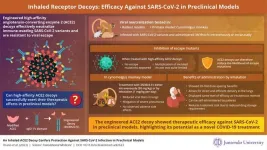(Press-News.org) DURHAM, N.C. – Researchers have developed a blood test that detects Parkinson’s disease, potentially establishing a way to help diagnose the condition before nervous system damage worsens.
A new blood-based diagnostic test would be a major advancement for Parkinson’s disease, which afflicts 10 million people worldwide and is the second-most common neurodegenerative disease after Alzheimer’s. Led by a team of Duke Health neuroscientists, the study appears Aug. 30 in the journal Science Translational Medicine.
“Currently, Parkinson’s disease is diagnosed largely based on clinical symptoms after significant neurological damage has already occurred,” said senior author Laurie Sanders, Ph.D., an associate professor in Duke School of Medicine’s departments of Neurology and Pathology and member of the Duke Center for Neurodegeneration and Neurotherapeutics.
“A simple blood test would allow us to diagnose the disease earlier and start therapies sooner,” Sanders said. “Additionally, a clear-cut diagnosis would accurately identify patients who could participate in drug studies, leading to the development of better treatments and potentially even cures.”
As a biomarker for their diagnostic tool, Sanders and colleagues focused on DNA damage in the mitochondria. Mitochondria are factories within cells that convert raw energy into a form that powers cells. They contain their own DNA, which can undergo damage separately from the nuclear DNA that encodes most of an organism’s genome.
Earlier studies have associated mitochondrial DNA damage with an increased risk of Parkinson's disease, and the Duke-led team had previously reported an accumulation of mitochondrial DNA damage specifically in the brain tissue of deceased Parkinson’s patients.
Using polymerase chain reaction (PCR) technology, the Duke team developed an assay that successfully quantified higher levels of mitochondrial DNA damage in blood cells collected from patients with Parkinson’s disease compared to people without the disease.
The new test also identified high levels of the damaged DNA in the blood samples of people who harbor the genetic mutation LRRK2, which has been associated with an increased risk of the disease. The assay was able to detect patients with Parkinson’s disease with and without LRRK2 mutations.
A further analysis in cells from patients with Parkinson’s disease explored whether the team’s PCR-based test could determine the effectiveness of a therapy that targets the effects associated with LRRK2 mutation.
In these samples, the test identified lower mitochondrial DNA damage in cells treated with a LRRK2 inhibitor compared to samples from patients who did not receive the inhibitor. This suggests the assay could help pinpoint Parkinson’s disease patients who might benefit from LRRK2 kinase inhibitor treatments, even if they do not have a LRRK2 mutation.
“Our hope is that this assay could not only diagnose Parkinson’s disease, but also identify drugs that reverse or halt mitochondrial DNA damage and the disease process,” Sanders said. “This disease takes a terrible toll on people, and we are still just treating the symptoms. It’s important to get new, effective treatments over the finish line.”
Sanders said the research team’s future will include further testing of the assay in samples from patients with the earliest stages of disease, before symptoms develop.
In addition to Sanders, study authors include Rui Qi, Esther Sammler, Claudia P. Gonzalez-Hunt, Ivana Barraza, Nicholas Peῆa, Jeremy P. Rouanet, Yahaira Naaldijk, Steven Goodson, Marie Fuzzati, Fabio Blandini, Kirk I. Erickson, Andrea M. Weinstein, Michael W. Lutz, John B. Kwok, Glenda M. Halliday, Nicolas Dzamko, Shalini Padmanabhan, Roy N. Alcalay, Cheryl Waters, Penelope Hogarth, Tanya Simuni, Danielle Smith, Connie Marras, Francesca Tonelli, Dario R. Alessi, Andrew B. West, Sruti Shiva, and Sabine Hilfiker.
The study received support in part from the Michael J. Fox Foundation for Parkinson’s Research; the Mitochondria, Aging & Metabolism Seed Grant Program; the William N. & Bernice E. Bumpus Foundation; the Pepper Center at the University of Pittsburgh; the Medical Research Council; the Chief Scientist Office Senior Clinical Academic Fellowship; the National Health and Medical Research Council of Australia Leadership Fellowship; Busch Biomedical Research; and the National Institutes of Health (F31NS089111, 1K23AG076663, R01NS064934, P50AG005133, RO1NS119528).
###
END
The surface protein of the severe acute respiratory syndrome coronavirus 2 (SARS-CoV-2), known as the spike protein, is critical for infecting host cells. The spike protein facilitates the infection process by binding to angiotensin-converting enzyme 2 (ACE2) receptors on the surface of airway epithelial cells, initiating the virus entry into the cells. By engineering an ACE2 receptor to increase the affinity to the spike protein, researchers demonstrated a novel method to neutralize the virus effectively. The engineered ACE2 (3N39v4-Fc) acts as a decoy by binding to the viral spike protein, thus preventing the binding of viruses to the ACE2 receptor on the cell surface. ...
New Curtin research into injuries sustained by trail users has found mountain biking is not the dangerous, injury-plagued sport reserved for thrill-seekers that it is often perceived to be and that the health benefits outweigh the risks.
Researchers analysed data from dozens of studies across the world, including Australia, encompassing 220,935 injured mountain bikers and 17,757 injured hikers. The study aimed to pinpoint the injury types and affected body areas in order to gain insights into the medical treatment of such cases.
Lead author PhD candidate Paul Braybrook, from Curtin’s School of Nursing, said mountain bikers were primarily injured on their upper limbs, ...
The same neurons that help bats navigate through space may also help them navigate collective social environments, finds a new study published today in the journal Nature.
Many mammals — including bats and humans — are believed to navigate with the help of a brain structure called the hippocampus, which encodes a mental “map” of familiar surroundings. For example, as you walk around your neighborhood or commute to work, individual “place” neurons in the hippocampus fire to indicate where you are.
In the new study, researchers at the University of California, Berkeley, used wireless neural ...
WEST LAFAYETTE, Ind. and WINNIPEG, Manitoba – IHT Group, a division of Decisive Dividend Corp. (TSXV: DE) based in Winnipeg, Manitoba, is bringing patented cooling pad technology for hogs to the North American market in spring 2024.
The pads are 2-foot-by-4-foot aluminum tread plates on top of copper pipes that circulate water. Sensors in the pads determine if the hog is too hot and circulate new water to keep the pad cool. The technology was designed by researchers in Purdue University’s Department of Agricultural and Biological Engineering and Department of Animal Sciences.
Heat harms hogs
Record heat across North America ...
CHAMPAIGN, Ill. — When an immunocompromised person’s system begins to recover and produce more white blood cells, it’s usually a good thing – unless they develop a potentially deadly inflammatory condition. New research from the University of Illinois Urbana-Champaign has found that the pulmonary distress often associated with the condition is caused not by damage to the lungs, but by newly populated T-cells infiltrating the brain.
Knowing this mechanism of action can help researchers and ...
Venice, Italy – The International Society of Microbiota (ISM) is pleased to announce the upcoming symposium on probiotics and microbiota supplements. The symposium will take place on October 17, 2023, in Venice, Italy, one day prior to the 10th World Congress on Targeting Microbiota 2023.
About ISM 2023 Symposium:
The symposium will focus on the strain specificity of probiotics and microbiota supplements and their clinical applications for disease management. It will also elaborate on the use and mode of action of postbiotics and metabolites like the SCFA butyrate.
Speakers will present the latest research on the use of probiotics to treat a variety ...
[Boston, MA, USA—August 30, 2023] Each year, the American Meteorological Society recognizes outstanding individuals and organizations in the weather, water, and climate community through its Awards and Honors program. The organization is proud to announce its 2024 recipients, who will receive their award or honor at the 104th AMS Annual Meeting in Baltimore, Maryland, 28 January–1 February, 2024.
“Working across a wide range of sciences and services, the members of our community are vital to upholding safety and quality of life in the United States and across ...
While self-driving vehicles (SDVs) are being hailed as a solution for safer, more efficient roads, new research suggests British Columbians are not quite ready to embrace self-driving cars wholeheartedly – and will need a period of gradual transition before adoption.
The study, conducted by the Research on Active Transportation Lab (REACT) at the University of British Columbia, reveals mixed perceptions of automated vehicles, particularly their effects on pedestrian comfort and safety.
Do self-driving cars feel safe?
Four out of 10 participants (41 per cent) thought that pedestrians faced reduced safety and comfort levels ...
HOUSTON ― The University of Texas MD Anderson Cancer Center’s Research Highlights showcases the latest breakthroughs in cancer care, research and prevention. These advances are made possible through seamless collaboration between MD Anderson’s world-leading clinicians and scientists, bringing discoveries from the lab to the clinic and back.
Recent developments include a novel computational tool to detect single base pair DNA changes in single-cell sequencing data, a potential target to treat hypertension caused by drugs commonly used in organ transplants, further insights into the steps involved in ...
Research conducted at Columbia University Mailman School of Public Health detected significant levels of metals in the blood and urine among marijuana users, concluding that marijuana may be an important and under-recognized source of lead and cadmium exposure. This is among the first studies to report biomarker metal levels among marijuana users and most likely the largest study to date, that links self-reported marijuana use to internal measures of metal exposure, rather than just ...



